A collection of odds and ends from various communications (to eliminate the historic "what's this ??? syndrome).
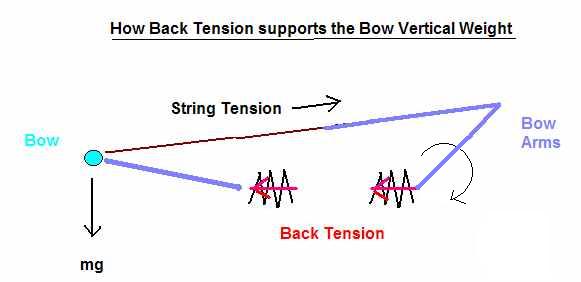
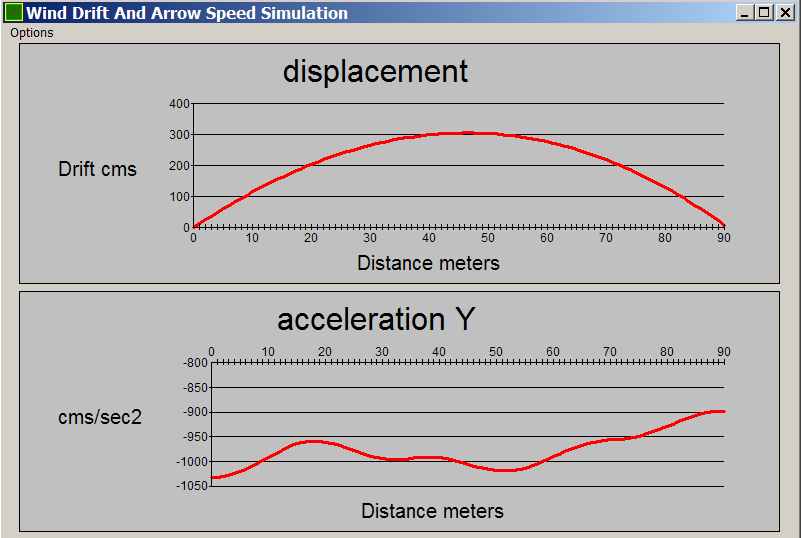
Note includes the -981 cms/sec squared gravity acceleration .
55 m/s is taken as typical arrow launch speed. Both vacuum and air drag situations are modelled. Minimum launch speed to reach 90m is around 30m/s.
The reason for the "high draw" and "low draw" positions is shown as resulting from the "Sine" relationship of bow angle to distance.
The second graph illustrates how variation of bow angle with launch speed is approximately linear over a practical range. (Basis of many sight mark estimator programs). For Olympic recurve bows the practical maximum bow angle is around 8 degrees. More than this then either the archer runs out of sight mark adjustment (off the bottom end of the sight bar or the sight is pin is too close to the arrow for clearance comfort) or the end of the long rod rises between the eye/pin and the target.
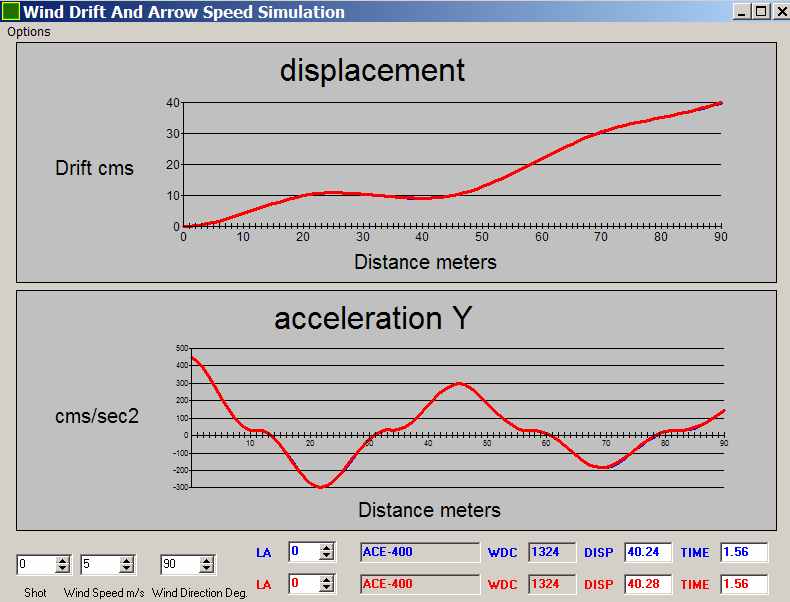
An example of what happens when the de-stabilizing torque on the arrow from air flow separation exceeds the stabilizing torque on arrow from the fletching action
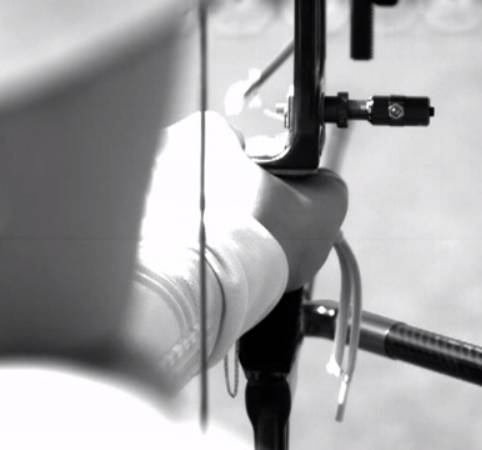
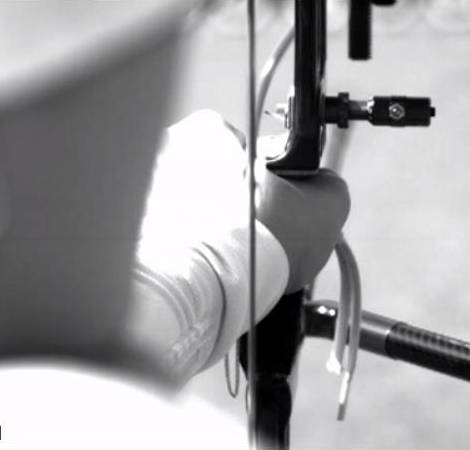 Stills from Lloyd Brown high speed film of Park Sung-Hyung
Stills from Lloyd Brown high speed film of Park Sung-Hyung
The basic premise that the (indoor shooting) line cutting behaviour of an arrow is a balance between the arrow diameter and how "forgiving" the arrow is. The more forgiving the arrow the nearer the centre it hits, the wider the arrow the nearer the shaft edge is to the centre. The question is which of the two characteristics is the dominant one.
Using the Drift simulator two arrows are compared for their line cutting characteristics:
Both arrows have the same fletching size, weight and position.
For the arrow hit on a target at 18 metres the graph plots the distance from the edge of the shaft to the target centre as the launch angular velocity
is varied.
In this case if the arrow hits very close to the centre than the X7 shaft edge is nearer the centre than for the X10. At around 3-3.5 cms the two arrow
shafts are indistinguishable as regards line cutters. More than 3.5 cms from the centre than the edge of the X10 lies nearer the centre. Both arrows are equivalent
as regards the Easton table. The X7 may possibly have a slightly higher line cutting probability than the X10 with respect to the 10/9 line.
Outside of
this the X10 will have the higher line cutting probability.
The more forgiving arrow will give a better result with any poor shots (9,8,7...). For 10/9 line cutters I don't think any obvious generalisation can be made as to which is better, it's going to depend on the two specific arrows.
For example the exercise is repeated with the only change being the X10 point weight being increased from 100 to 120 grains. Unsurprisingly the higher FOC swings the
pendulum towards the X10 as being the better performer as far as arrow line cutting goes. The "break even point" drops from around 3.5cm to 2.5cm.The other option is the purpose built extremely wide arrow shaft with a very
heavy point (e.g. pouring lead into the front) adjusted to make the arrow work with the bow. As these arrows are off the selection charts no attempt to predict their
properties is made.
The above two graphs make the assumption that the tuning of the bow is perfect for 18 metres. If you change the bow setup basis to include an arrow launch with a
one degree attack angle (alignment) and repeat the above exercise with the 120 grain X10 point then the effect on the "line cutting" arrow characteristics is quite
significant.
This suggests that a minimum requirement of going the very wide shaft/heavy point route is that the tuning of the arrow becomes critical as well as the quality of the shot.
Having suggested that as far as line cutting goes the thin carbon arrow is likely to be preferred to a "fat aluminium" one what about the large fletching size
often suggested to go with it. The attached graphs illustrate how far the arrow edge is from the spider as a function of launch angular velocity as the effective
fletching area is changed. The arrow used is as before an X10 550 only this time with a 110 grain point. Target distance is again 18 meters.(Note that the horizontal
scale is not linear).The point under consideration is that the larger the
fletching area the more torque there will be rotating the arrow & hance reducing the lateral acceleration with respect to the airflow angle of attack. On the other
hand the larger the fletching area the bigger the overall cross sectional drag area and so a larger arrow lateral acceleration for any given angle of attack.
With high launch angular velocity and hence high lateral displacement clearly the larger fletching works better i.e. the higher torque property outweighs the higher cross sectional area property.
With a lower launch angular velocity then we get the reverse of the above. As the fletching area increases the arrow hits further way from the spider (this being in the region for a 10/9 line cutter for a Fita 18).The overall cross sectional area property ouweighs the higher torque property. This suggests that the optimum fletching area is probably larger than the outdoor (wind present) one but a lot smaller than large feather fletching suggestions. Another consideration is that any launch misalignment (angle of attack) will swing the pendulum towards the smaller fletching size as the direction of change of angle of attack will be from maximum down rather that from the zero up you get from any launch angular velocity. The best fletching size can only be determined by testing by the individual archer with their arrow and bow set up.
Some References:
A question that often crops is which is better a longer arrow with a high draw weight or a shorter arrow with a lower draw weight. It is sometimes presented as who has the advantage the gents or the ladies.
Like most archery questions in absolute terms it probably doesn't have an meaningful answer. It's rather like the frequent "which is the best arrow shaft" to which only the respective arrow manufacturers have (different) answers.
Here a simple comparison is made between two arbitrary arrows. The result probably depends on which arrows you select for comparison, The two arrows compared have
the following launch properties:
Variation of the in flight arrow speed and kinetic energy are presented. Calculations are made with the Drift program assuming no gravity and no wind. Unsurprisingly the longer, heavier and higher draw weight X10-410 has the higher speed and kinetic energy.
The long heavy arrow has nearly twice the energy of the short light arrow. The graph is included only to yet again try to dispel the "down range energy is good" myth. A brilliant piece of marketing but that is all it is.
Graphs are presented for the relative group sizes obtained at 70m as the archer's ability varies (represented by maximum launch angular
velocity). Groups for no wind and with a 5 m/s crosswind are presented.
With no wind the shorter, lower draw weight, high FOC arrow performs better, as regards grouping, than the longer, heavier draw weight arrow. With a wind the grouping behaviour of the two arrows is much the same. Overall on one sample you have to go with the FOC being the dominant performance parameter; the shorter lighter and slower arrow is more forgiving.
The comparison is repeated by reversing the draw weights i.e. short arrow with high draw weight and long arrow with low draw weight.
Selection arrow details (using the Easton Shaft Selector) are:
The group sizes for no wind and 5m/s crosswind become:
It is generally accepted that bow tuning mainly concerns itself with the rotation the arrow has coming out of the bow. All viable quick tuning methods are about detecting the amount and direction of any such rotation (e.g. paper and bare shaft tuning) and having rules about what bow adjustments to make to improve the tuning. Directly observing arrow rotation on high speed video is not generally feasible. One published video which does seem to enable rotation to be seen is one of the the Beiter "Way to the Centre" videos. Some screen captures from this video are appended:
The are many arrow speed launch calculation utilities available on the internet. They fall into two basic groups:
- Estimating arrow speed/sight marks from the bow and arrow properties (draw weight, draw length, arrow mass etc)
- Estimating arrow speed/sight marks based on the sight mark at two different distances.
Always better to make estimates from actual measured values rather than pure theory so the sight mark approach is to be preferred. A couple of such archery calculators are Arrow speed 1 and Arrow speed 2. Both these calculators are found to produce results of acceptable accuracy.
Both these calculators use the simple ballistic (parabolic) trajectory for the calculation i.e. any drag effects on the arrow flight are ignored. How valid an approach is this?. It should be said that using flakey aerodynamics in arrow tractory calculations (pin tape programs come to mind) can produce larger errors in the results then assuming the arrow is shot in a vacuum.
It is mentioned elsewhere on this site that the drag and lift effects on an arrow cancel each other out to a large extent so the deviation (at least at short distances) from the pure ballistic parabola is fairly small. This is the reason this approach works so well.
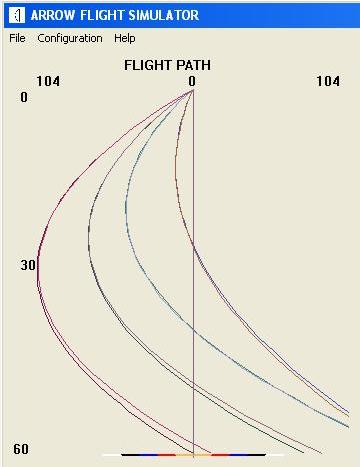 To get some idea of the limits for a ballistic approach the difference in arrow trajectories for the drag and no-drag cases are compared at various distances. The
associated graph is generated using the Arrow program which calculates, if only in a simplistic way, the drag effects on the arrow.
To get some idea of the limits for a ballistic approach the difference in arrow trajectories for the drag and no-drag cases are compared at various distances. The
associated graph is generated using the Arrow program which calculates, if only in a simplistic way, the drag effects on the arrow.
Arrows are shot at four different bow angles to hit at four different points beween 0-60 metres. The graph illustrates the trajectories in the vertical plane (tilted
sideways). At each bow angle (1.32, 2.60, 3.25 and 3.96 degrees) the arrow flight is simulated in a vacuum (air density zero) and with drag (air density 1.2gms/litre).
It can be seen that up to around 40 metres the drag/no drag trajectories are virtually identical. Beyond 40 metres the arrow tractories diverge; the further the distance the bigger the divergence. Clearly this behaviour will depend on the arrow/speed in any particular instance. In this case an arbitrary arrow is used but you can repeat the excercise if wanted with the arrow of your choice.
The graph suggests different strategies in the way you use the calculator depending on what you are trying to do. If your aim is to determine the out of the bow arrow speed then the two sight marks used should be close enough to be within the no drag effect region e.g. in this case say 20m and 40m. On the other hand if you want to get estimated sight marks on all distance out to 90 meters then the second sight mark should be at the farthest distance practicable to allow to some degree for the arrow drag.
If the arrow does not flex within an acceptable frequency range for the bow set up then one usual consequence is the rear of the arrow hitting the riser on the way past. This can occur if the arrow flexes too quickly (called stiff) or too slowly (called weak). As part of any recurve bow set up process a check is made that you have good arrow clearance using video, lipstick, spray powder etc., anything that will flag any arrow riser contact.
The attached is a video from D.K. Lieu recording a case of major arrow-riser contact, along with a couple of stills from the video.
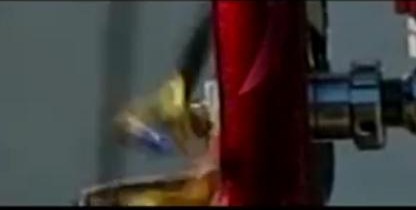
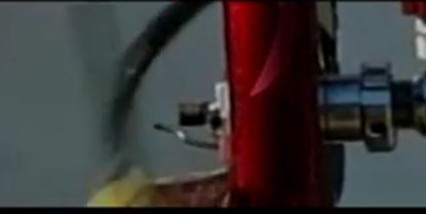
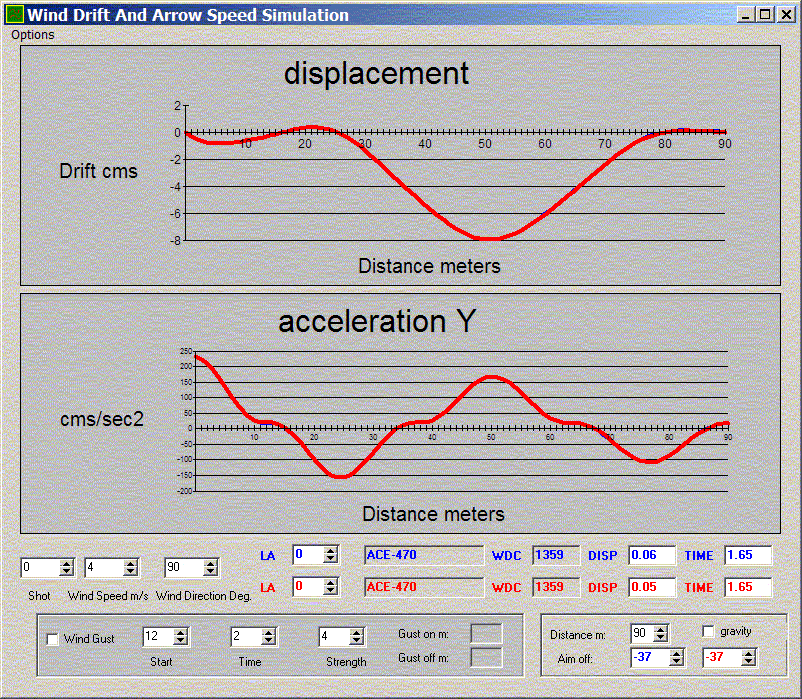 1. Normal situation - archer aiming off in constant right to left 4m/s crosswind, Arrow hitting the target centre.
1. Normal situation - archer aiming off in constant right to left 4m/s crosswind, Arrow hitting the target centre.
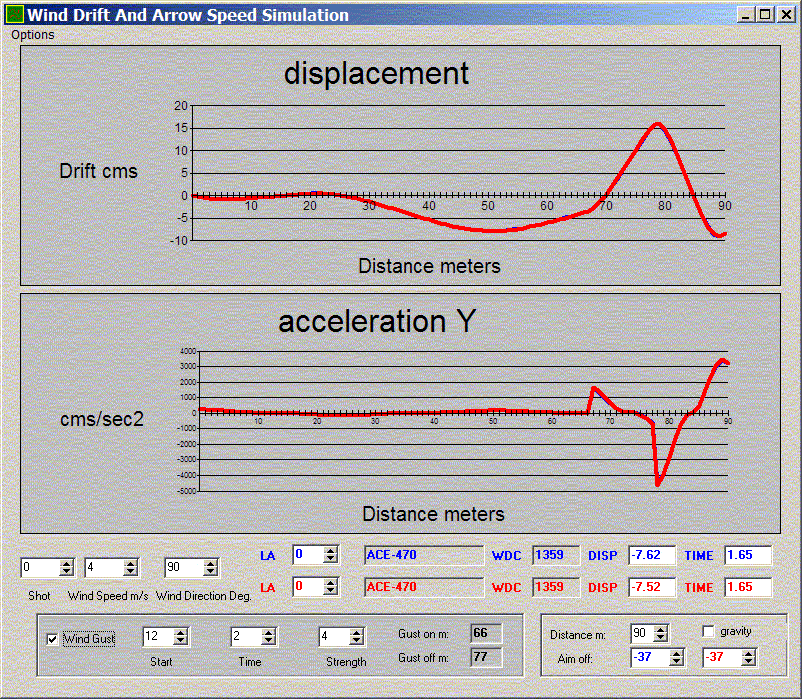 2. Arrow hit by a short duration right to left wind gust at 66m distance. Consequence is that the arrow hits the target upwind to where it
was hitting without the gust.
2. Arrow hit by a short duration right to left wind gust at 66m distance. Consequence is that the arrow hits the target upwind to where it
was hitting without the gust.
The reason for the effect is that the wind gust kicks the tail of the arrow around and hence (see graph) generates a significant acceleration of the arrow in the upwind direction. The arrow hits the target before the arrow can recover from this kick
This is a very freakish combination of factors so a very remote possiblity of anyone observing it. In many years of archery I've only come across two cases where archers thought this might have occured (both compound archers incidentally).
One of the reasons for spinning arrows is to even out the arrow fletching action. The ideal for this function would be to have no attached fletchings and just to use the shaft drag with a high FOC. In practice we have to add some extra fletching area to the back of the arrow. An annular ring fletching would provide a consistent, arrow orientation independant, fletching action but this would incur too much mass and drag. The compromise is to fit three individual fletchings (light and low drag) and spin the arrow fast enough, using the fletchings, so that the fletching area variations are smoothed out giving a consistent fletching action.
Not everybody follows the rule book all of the time. Here is link to a video example of an elite archer using flat fletching and no offset (i.e. no assigned spin) in a tournament environment. Aida Roman
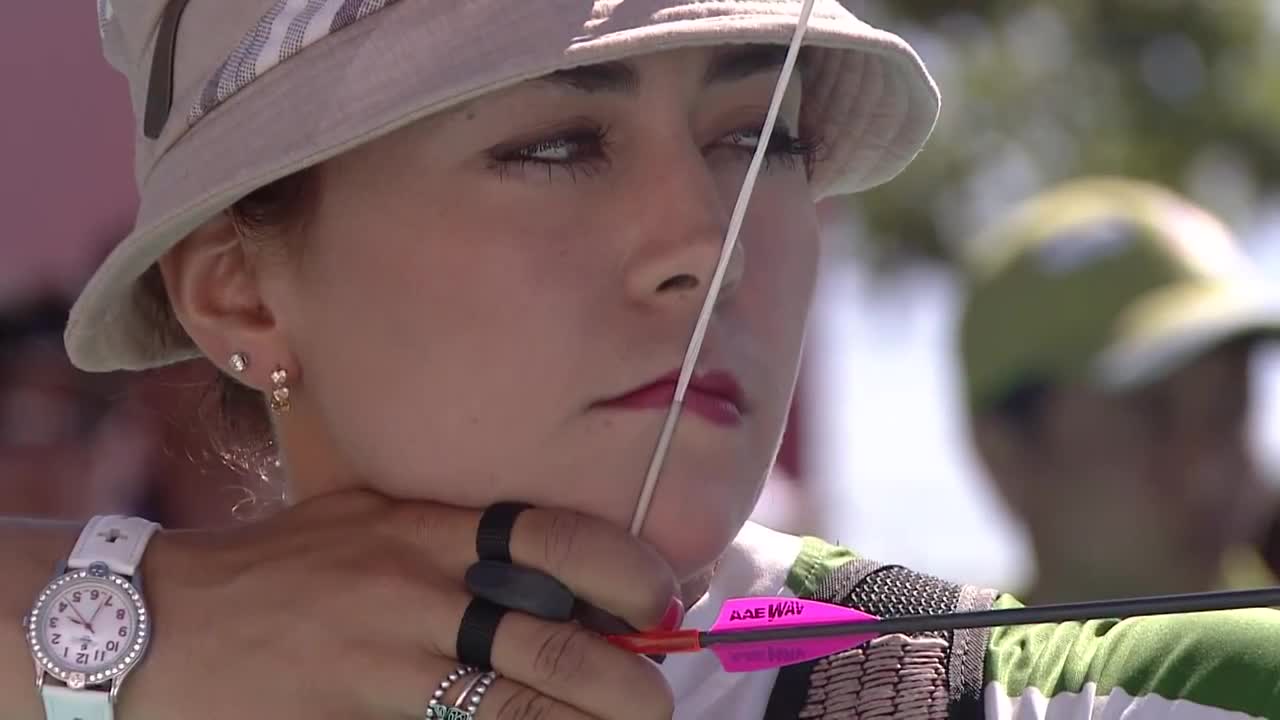 Here is the fletching being used, plastic vane with no offset.
Here is the fletching being used, plastic vane with no offset.
The following are high speed selections from the main video:
As a side note if you watch the behaviour of the nock in the above video sequences you can see that it moves linearly from side to side corresponding to the vibration of the arrow shaft. If you look at the nock behaviour of an arrow fitted with say spin wings coming out of the bow you see the nock following a circular/elliptical path. The reason for this is the shaft vibration and fletching generated shaft spin via drag generate this nock precessional effect. With no spin you dont get this effect - these days rarely seen.
Last Revision 26 September 2014